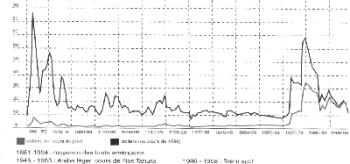The symbolic bar of $ 50 a barrel of oil has been crossed in recent days.
Yes, the media are right: in absolute terms, oil has never been so expensive, but what about in relative terms? Taking into account the level of inflation and the cost of money?
In this case, the media are seriously mistaken as shown by the following curve whose barrel prices were reported at 1998's dollar price.

Crude quotation from 1860, in current and constant currency. Source: CME, click to enlarge
In the early 80s, oil was therefore much more expensive than now, since it was, in 1998 dollars, close to $ 70. Obviously it was the consequences of the 2nd oil crisis but the prices were still well above $ 50 for almost 4 years!
Another point that should currently be taken into account in the price of oil: CO2 emissions.
Some experts estimate the cost (environmental future) to be between $ 10 and $ 40 per tonne of CO2 released into the atmosphere. Others speak, but it is undoubtedly abusive, from 80 to 100 $. Consider a reasonable low average of $ 20 a tonne.
A ton of oil burned on average 2.5 times its mass form CO2.
A barrel weighs 127 kg and will therefore reject 320 kg of CO2 approximately.
Hence an “extra cost” per barrel of 0.32 * 20 = $ 6.4. Or more than 10% the current price. So much more on a weak barrel. With the high estimate at $ 100 per tonne, we multiply this figure by 5, or more than 50% increase and more than 100% increase with a barrel at $ 25.
More:
- The real price of oil corrected by inflation
- Money and income from crude oil
- Purchasing power, minimum wage and oil: how many hours of work?

Number of working hours required since 1990 to buy oil, in constant currency. Source: Econologie.com, click to enlarge

